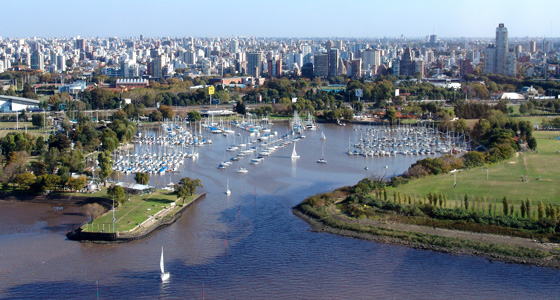Capital City: Buenos Aires Area: 2.8 million sq. km (1.1 million sq. miles)
Languages: Spanish
Monetary Unit: 1 Argentine Peso
GDP Growth: 8% (2011 est.)
Unemployment: 7.2% (2011 est.)
Overview:
The last decade has seen Argentina transform itself; today, Argentina has a robust economy, a solid currency and a strong export market. It is one of South America’s largest economies, rich in natural commodities and has a well-educated workforce. A country with a positive outlook, Argentina is the third most optimistic country in Latin America about its future economic strength, according to the 2011 Grant Thornton International Business Report (IBR).
With a vibrant culture Argentina’s European roots are reflected in the country’s architecture, music, literature and general lifestyle. Sport is an important part of its culture with Football and Polo being the nation’s favourites. Argentina’s “Asado” cuisine is also renowned the world over.
Geography:
As the second largest country in South America after Brazil, Argentina stretches over 4,000 km of diverse panoramas from tropical climates in its northern regions to sub-Antarctic conditions in its southern tip. Argentina’s landscape includes the Andes mountain range, the plains of the Pampas, is home to the Western Hemisphere’s tallest mountain – Cerro Aconcagua – and a long coastline along the South Atlantic and South Pacific Oceans.
Argentina’s demographic density is concentrated around the country’s urban centres with the population split between urban and rural areas 88% to 22% respectively. Nearly half of Argentina’s population is located in and around the capital city of Buenos Aires (Source: indec.gov).
Natural Resources:
Argentina is a resource rich country. Its fertile plains of the pampas provide it with idyllic conditions for agricultural production for which it is well known for. China has invested heavily in Argentina for the production of food and energy resources, investing US$3,530 million in Argentina alone in 2011 (Source: ft.com). Argentina is the world’s biggest exporter of soy oil and is a major player in the booming international bio fuels sector (Source: reuters.com). Other natural commodities found in Argentina include lead, zinc, tin, copper, iron ore, manganese, petroleum and uranium (Source: CIA World Factbook).
Government:
Argentina is a representative democracy headed by President Cristina Fernandez of the Justicialist Party – the first female and 55th president of Argentina (Source: CIA World Factbook). She was voted in for a second term in October 2011 winning a majority 54% of votes (Source: BBC.co.uk). During her first term she has championed economic growth, human rights, health improvement and sought to address poverty imbalances. Since its peak in 2002, poverty has been reduced by two thirds as employment has reached record levels whilst government spending on social initiatives has tripled (Source: guardian.co.uk).
Economy:
According to The Economist, “Argentina has entered the ranks of the faster-growing Latin American economies”. It is the third largest economy in Latin American, an upper middle-income country and has a high quality of life.
Argentina has demonstrated robust economic growth in recent years with GDP growth an impressive 9.2% in 2010, according to the World Bank. The IMF has forecast 8% growth in 2011 and 4.6% in 2012. The government has implemented significant reforms since the 2001-2002 crisis that have strengthened the country’s economic position, making it the 3rd largest economy in Latin America and the western hemisphere’s fastest growing economy between 2002 and 2011. Although GDP growth is expected to slow in 2012 to between 4% and 5%, future growth is expected to exceed world averages for the foreseeable future.
Banking System:
Following Argentina’s financial crisis of 2001, the country learned many lessons and today has a regulatory framework that is increasingly prudent. This, in conjunction with its relatively modest size, has stood the country in good stead during the recent global economic crisis, with its financial system showing considerable resilience (Source: Moody’s – bnamericas.com). Its low exposure to international capital markets, low loans to GDP ratio – the lowest in the region – and low non-performing loans even throughout the 2008-2009 financial crisis, supports the banking systems stability (Source: Moody’s)
Tourism:
Argentina has a buoyant tourism industry that is an important sector in the country’s economy; tourism accounted for 5% of GDP in 2011 and employs 10% of the country’s total workforce. The World Tourism Organisation (UNWTO) recently reported that Brazil and Argentina were the leading tourism countries in South America, which as a whole saw tourist inflows increase by 10% in 2011, three times higher than the world average. In 2012, Argentina expects to attract 6 million visitors (Source: euromonitor.com)
In 2010, Argentina established the Ministry of Tourism, INPROTUR, to promote the country’s unique tourism attributes and attract mid- to high-end spending international visitors. Supporting this, Intercontinental – the luxury brand of the InterContinental Hotel Group (IHG) opened a new hotel in Buenos Aires in 2011, and Qatar Airlines launched a Doha-Sao Paulo flight via Buenos Aires, a highly strategic route that will bring important business links to Argentina (Source: euromonitor.com).











